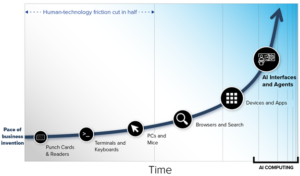Generative AI (genAI) arrived in 2022 with massive expectations, promising to transform everything. But two years later, the initial excitement is shifting to skepticism, with many now demanding, “Show me the money!” While no one doubts AI’s potential, the pressing question remains: When will AI truly deliver, and should your organization wait or dive in now?
While this is a valid moment in time to be asking these questions as enterprises navigate the scope and scale of AI adoption, we are on the brink of a profound technological transformation — but like all human changes, it’s going to take time. Forrester has released a new report titled Change The Interface; Change The World, in which we take a long-term view spanning 10 to 20 years during a time period when we believe that we are merely at the beginning of a new era of “AI computing” — an era when intuitive AI-driven interfaces and powerful AI agents will redefine how companies interact with people.
We refer to this shift as “AI computing” because the technological leap is as significant as the transition from the internet to mobile computing. Mobile meant meeting people at their moment of need; AI computing will change human needs over time. This is a disruptive force we have not seen before.

Charting The Future Through Three Paths Of Change
Imagine if you handed a 1950s office worker a BlackBerry and asked them to envision the mobile revolution. We’re in a similar moment with AI. AI’s potential far exceeds what we can practically conceive of happening today.
But consider this: Experts constantly point out how AI advances are arriving far faster than anticipated. Recently, a Google researcher developed a neural network that recreated a playable version of the classic game “Doom” — without traditional game-engine coding. Meanwhile, Sakana AI, a Japanese research firm, recently demonstrated an AI agent that can produce “weak accept”-grade academic papers for a mere $15 in computing costs. In Sakana AI’s blog, they reflect on how what was once a joke among AI researchers — having AI write research papers for them — is now almost a reality.
These examples are just the beginning: AI computing will wipe away decades of junk websites, thousands of apps, and old, stale data. It will redefine business models as it goes. Our report identifies three key paths of change that AI computing will drive:
- AI computing will create AI-advantaged lives. AI will empower individuals with tools that make their daily lives more seamless. Advanced technologies will become more accessible, intuitive, and responsive, driving new ways of living and working. AI’s ability to understand and respond to human needs, personally and in real time, will be central to this shift, but this transformation will take time, as the pace at which humans can embrace change is always a limiting factor, not to mention that our models need to get a lot better (they will!).
- AI computing will enable companies to reinvent knowledge economies. AI will reshape how companies create value through knowledge. AI-native work processes will emerge from simple task automations, creating new opportunities to serve AI advantaged humans. This reinvention won’t happen overnight — as billions of people live, create, and work in entirely new ways, businesses and governments will need to try (and often fail) to innovate around new needs.
- AI computing will revolutionize high-technology markets. Language-based methods of creating software are set to replace traditional coding. Businesses that are dependent on complex, expensive software will be challenged while opportunities abound. This transition will take time, driven by technology refresh cycles and a rapid pace of innovation that will inevitably lead many AI technology innovators down dead ends.
Build A Knowledge Loop
How can your organization prepare today? Our report introduces the “knowledge loop,” a cycle where your organization’s data and institutional knowledge are continuously harnessed through AI. Most companies already have big data — documents, databases, warehouses, lakes, etc. And you also have even more tacit knowledge — buried in your experts’ heads, present in all communications, lurking inside customer interactions … the list goes on. How do you harness all of this and put it to work? The key is a virtuous cycle that turns all this information into a business-defining knowledge asset that grows and grows as AI advances. Intrigued? Hope so.
Join The Conversation At Forrester’s Technology & Innovation Summit
The AI journey will be complex. Many firms won’t survive, but those that do will be the ones turning AI computing into differentiating value. I’d love to hear your story and explore these ideas at our Technology & Innovation Summit next week. I encourage you to join me and my colleagues there.








